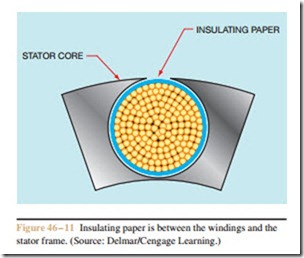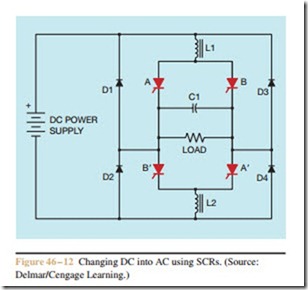Inverter Rated Motors
Due to the problem of excessive voltage spikes caused by IGBT drives, some manufacturers produce a motor that is inverter rated. These motors are specifically de- signed to be operated by variable frequency drives. They differ from standard motors in several ways:
1. Many inverter rater motors contain a separate blower to provide continuous cooling for the motor regard- less of the speed. Many motors use a fan connected to
the motor shaft to help draw air though the motor. When the motor speed is reduced, the fan cannot maintain sufficient air flow to cool the motor.
2. Inverter rated motors generally have insulating paper between the windings and the stator core (Figure 46 – 11). The high voltage spikes produce high currents that produce a strong magnetic field. This increased magnetic field causes the motor windings to move, because like magnetic fields re- pel each other. This movement can eventually cause the insulation to wear off the wire and produce a grounded motor winding.
3. Inverter rated motors generally have phase paper added to the terminal leads. Phase paper is insulating paper added to the terminal leads that exit the motor. The high voltage spikes affect the beginning lead of a coil much more than the wire inside the coil. The coil is an inductor that naturally opposes a change of current. Most of the insulation stress caused by high voltage spikes occurs at the beginning of a winding.
4. The magnet wire used in the construction of the motor windings has a higher rated insulation than other motors.
5. The case size is larger than most three-phase motors. The case size is larger because of the added insulating paper between the windings and the stator core. Also, a larger case size helps cool the motor by providing a larger surface area for the dissipation of heat.

